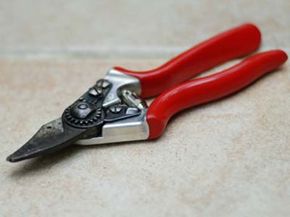Topiary Maintenance
Once you've created your topiary masterpiece, you'll want to keep up with it so it retains its trained or sculpted shape. Each kind of plant has different requirements and vulnerabilities, but clipping, watering and protection from the elements are the main ways to maintain your plant. You'll need to water and fertilize your topiary according to the type of plant you've selected, as well as protect it from extreme temperatures, insects and disease.
To maintain traditional topiary's shape, use the clipping tool that is appropriate for the size of your plant. Many plants used to create traditional topiary require clipping only annually to retain their shape. Generally, don't clip outdoor plants in extremely cold or hot weather. Spring is often a good time to take care of this task.
Advertisement
If you have a frame, use it to guide your pruning. If you are freehand pruning, cut slowly, a little bit at a time, to avoid clipping too much and damaging your plant. Prune from the top of the plant down. You can also maintain the shape of your traditional topiary and encourage new growth by pinching off stray ends of branches. Keep your plant healthy by removing any damaged or dead branches or leaves.
You can preserve the shape of sphagnum topiary by replacing dead or dying leaves and branches with healthy ones. Use florist's wire to hold stubborn pieces in place if necessary. Use your frame to guide trimming in areas where plants have grown too thick, and use healthy growth to cover bald spots.
To water sphagnum moss topiary, soak the structure in water if possible, and mist it as necessary.
Keep creeping plants used in trained ivy topiary in check by clipping and pinching off ends as necessary. Rearrange extra vines to cover thin spots in your topiary creation, and use florist's wire to train new growth. Remove dead pieces to keep your plant healthy.
Even if you don't have room in your backyard for a topiary giraffe or a six-foot-tall maze, you can use topiary to add spice and whimsy to your garden. Follow the links below to learn more about garden design and plant care.
Related HowStuffWorks Articles
- How to Design a Garden
- Garden Care Tips
- Tips for Growing Shrubs
- Common Boxwood
- American Yew
More Great Links
Sources
- Crowder, Christopher, and Michaeljon Ashworth. Topiary Design and Technique. Crowood Press. 2006.
- Dummies.com (Adapted from Biology for Dummies). "How Plants Get Water and Nutrients." Sept. 2, 2008. http://www.dummies.com/WileyCDA/DummiesArticle/How-Plants-Get-Water-and-Nutrients.id-1205.html
- Gallup, Barbara and Deborah Reich. The Complete Book of Topiary. Saunders of Toronto, Inc. 1987.
- Hendy, Jenny. Topiary: An Inspirational Guide to the Art of Clipping, Training and Shaping Plants. Anness Publishing Ltd. 2004.
- Hendy, Jenny. Quick and Easy Topiary and Green Sculpture. Storey Communications, Inc. 1996.
- International Association of Topiary Growers and Suppliers. "History of Topiary and Bay Trees." Sept. 2, 2008. http://www.topiary.org.uk/topiaryandbaytreehistory.htm
- Ladew Topiary Gardens. Sept. 2, 2008. http://www.ladewgardens.com/index2.html
- Levens Hall and Gardens. Sept. 2, 2008. http://www.levenshall.co.uk/
- Longstroth, Mark (Michigan State University Extension. "Water and Plant Growth." Sept. 2, 2008. http://www.canr.msu.edu/vanburen/watergrw.htm
- Old Deaf School Park. "Topiary Park Museum at Old Deaf School Park." Sept. 2, 2008. http://www.topiarygarden.org/park.htm
